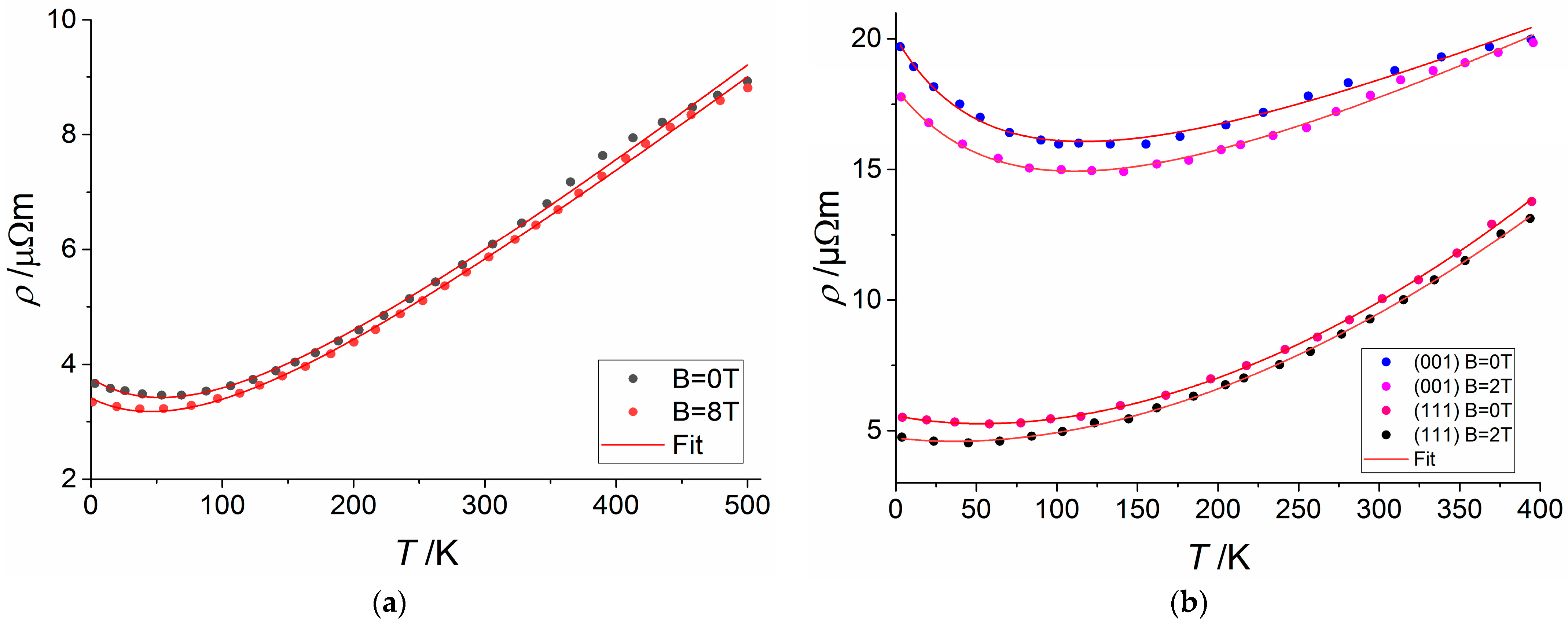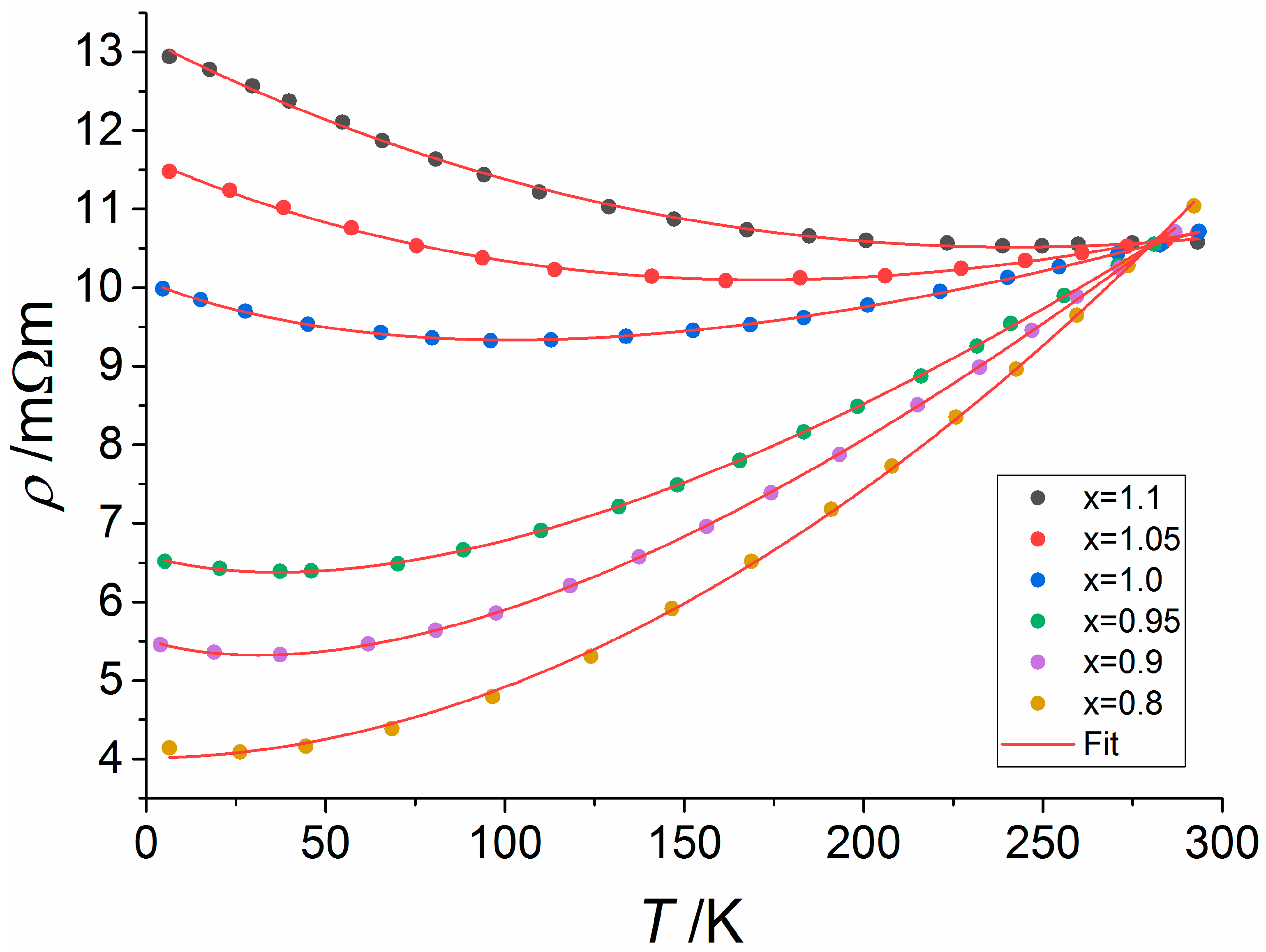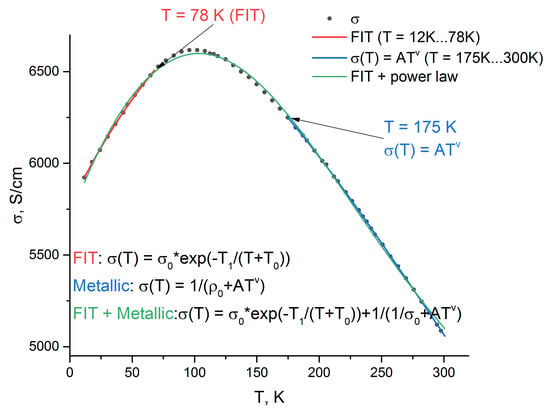The Origin of the Low-Temperature Minimum of Electrical Resistivity in Strontium Ferromolybdate Ceramics
Abstract
:1. Introduction
2. Materials and Methods
3. Results and Discussion
| SFMO Material | B, T | T1, K | T0, K | 1/ρ0, S/m | m | Rm, ΘmK−m | Ref. |
|---|---|---|---|---|---|---|---|
| Sintered 1 polycrystalline SFMO ceramics | 0 | 362.2 | 180.7 | 0.28 | 1.24 | 7.84 × 10−4 | [29] |
| 0.2 | 341.9 | 102.5 | 0.34 | 1.41 | 5.13 × 10−4 | ||
| 0.5 | 265.4 | 67.7 | 0.36 | 1.44 | 6.50 × 10−4 | ||
| 1 | 323.7 | 77.6 | 0.38 | 1.59 | 2.43 × 10−4 | ||
| 3 | 362.3 | 75.5 | 0.42 | 1.75 | 9.82 × 10−5 | ||
| 7 | 323.1 | 62.0 | 0.44 | 1.80 | 9.28 × 10−5 | ||
| SFMO ceramics 1 | 0 | 1541.7 | 492.6 | 14.6 | 3 | 1.19 × 10−9 | [70] |
| Thin film 2 | 0 | 1272.5 | 509.3 | 26.0 | 2.72 | 9.76 × 10−9 | [71] |
| 8 | 2003.8 | 831.6 | 28.2 | 2.40 | 5.20 × 10−8 | ||
| Thin film 2 | 0 | 88.0 | 84.5 | 42.1 | 2.9 | 1.93 × 10−9 | [72] |
4. Conclusions
Author Contributions
Funding
Institutional Review Board Statement
Informed Consent Statement
Data Availability Statement
Conflicts of Interest
References
- Suchaneck, G.; Kalanda, N.; Artsiukh, E.; Gerlach, G. Challenges in Sr2FeMoO6-δ thin film deposition. Phys. Status Solidi B 2020, 257, 1900312. [Google Scholar] [CrossRef]
- Grollier, J.; Querlioz, D.; Stiles, M.D. Spintronic nanodevices for bioinspired computing. Proc. IEEE 2024, 104, 2024–2039. [Google Scholar] [CrossRef] [PubMed]
- Mishra, R.; Kumar, D.; Yang, H. Oxygen-migration-based spintronic device emulating a biological synapse. Phys. Rev. Appl. 2019, 11, 054065. [Google Scholar] [CrossRef]
- Zhou, J.; Zhao, T.; Shu, X.; Liu, L.; Lin, W.; Chen, S.; Shi, S.; Yan, X.; Liu, X.; Chen, J. Spin–orbit torque-induced domain nucleation for neuromorphic computing. Adv. Mater. 2021, 33, 2103672. [Google Scholar] [CrossRef] [PubMed]
- Chmaissem, O.; Kruk, R.; Dabrowski, B.; Brown, D.E.; Xiong, X.; Kolesnik, S.; Jorgensen, J.D.; Kimball, C.W. Structural phase transition and the electronic and magnetic properties of Sr2FeMoO6. Phys. Rev. B Condens. Matter Mater. Phys. 2000, 62, 14197–14206. [Google Scholar] [CrossRef]
- Kim, T.H.; Uehara, M.; Cheong, S.-W.; Lee, S. Large room-temperature intergrain magnetoresistance in double perovskite SrFe1-x(Mo or Re)xO3. Appl. Phys. Lett. 1999, 74, 1737–1739. [Google Scholar] [CrossRef]
- Niebieskikwiat, D.; Caneiro, A.; Sánchez, R.D.; Fontcuberta, J. Oxygen-induced grain boundary effects on magnetotransport properties of Sr2FeMoO6+δ. Phys. Rev. B Condens. Matter Mater. Phys. 2001, 64, 180406. [Google Scholar] [CrossRef]
- Suchaneck, G.; Kalanda, N.; Artiukh, E.; Yarmolich, M.; Sobolev, N.A. Tunneling conduction mechanisms in strontium ferromolybdate ceramics with strontium molybdate dielectric intergrain barriers. J. Alloys Comp. 2020, 860, 158526. [Google Scholar] [CrossRef]
- Takayama, H. Electron-phonon interaction in impure metals. Z. Phys. 1973, 263, 329–340. [Google Scholar] [CrossRef]
- Kondo, J. Resistance minimum in dilute magnetic alloys. Prog. Theor. Phys. 1964, 32, 37–49. [Google Scholar] [CrossRef]
- Matsushita, Y.; Bluhm, H.; Geballe, T.H.; Fisher, I.R. Evidence for charge Kondo effect in superconducting Tl-doped PbTe. Phys. Rev. Lett. 2005, 94, 157002. [Google Scholar] [CrossRef] [PubMed]
- Hien-Hoang, V.; Chung, N.-K.; Kim, H.J. Electrical transport properties and Kondo effect in La1−xPrxNiO3−δ thin films. Sci. Rep. 2021, 11, 5391. [Google Scholar] [CrossRef] [PubMed]
- Syskakis, E.; Choudalakis, G.; Papastaikoudis, C. Crossover between Kondo and electron–electron interaction effects in La0.75Sr0.20MnO3 manganite doped with Co impurities? J. Phys. Condens. Matter 2003, 15, 7735–7749. [Google Scholar] [CrossRef]
- Wang, Y.; Xie, C.; Li, J.; Du, Z.; Cao, L.; Han, Y.; Zu, L.; Zhang, H.; Zhu, H.; Zhang, X.; et al. Weak Kondo effect in the monocrystalline transition metal dichalcogenide ZrTe2. Phys. Rev. B Condens. Matter Mater. Phys. 2021, 103, 174418. [Google Scholar] [CrossRef]
- Lee, P.A.; Ramakrishnan, T.V. Disordered electronic systems. Rev. Mod. Phys. 1985, 57, 287–337. [Google Scholar] [CrossRef]
- Ziese, M. Searching for quantum interference effects in La0.7Ca0.3MnO3 films on SrTiO3. Phys. Rev. B Condens. Matter Mater. Phys. 2003, 68, 132411. [Google Scholar] [CrossRef]
- Suchaneck, G.; Artiukh, E. Absence of weak localization effects in strontium ferromolybdate. Appl. Sci. 2023, 13, 7096. [Google Scholar] [CrossRef]
- Maritato, L.; Adamo, C.; Barone, C.; De Luca, G.M.; Galdi, A.; Orgiani, P.; Petrov, A.Y. Low-temperature resistivity of La0.7Sr0.3MnO3 ultra thin films: Role of quantum interference effects. Phys. Rev. B Condens. Matter Mater. Phys. 2006, 73, 094456. [Google Scholar] [CrossRef]
- Kumar, D.; Sankar, J.; Narayan, J.; Singh, R.K.; Majumdar, A.K. Low-temperature resistivity minima in colossal magnetore-sistive La0.7Ca0.3MnO3 thin films. Phys. Rev. B Condens. Matter Mater. Phys. 2002, 65, 094407. [Google Scholar] [CrossRef]
- Herranz, G.; Sánchez, F.; Fontcuberta, J.; Laukhin, V.; Galibert, J.; García-Cuenca, M.V.; Ferrater, C.; Varela, M. Magnetic field effect on quantum corrections to the low-temperature conductivity in metallic perovskite oxides. Phys. Rev. B Condens. Matter Mater. Phys. 2005, 72, 014457. [Google Scholar] [CrossRef]
- Auslender, M.; Kar’kin, A.E.; Rozenberg, E. Low-temperature resistivity minima in single-crystalline and ceramic La0.8Sr0.2MnO3: Mesoscopic transport and intergranular tunneling. J. Appl. Phys. 2001, 89, 6639–6641. [Google Scholar] [CrossRef]
- Kalanda, N.; Demyanov, S.; Yarmolich, M.; Petrov, A.; Sobolev, N. Electric transport characteristics of Sr2FeMoO6–δ ceramics with structurally inhomogeneous surfaces. In Workshop Book, Proceedings of the 2nd International Workshop on Advanced Magnetic Oxides (IWAMO), Aveiro, Portugal, 24–25 November 2021; Department of Physic of the University of Aveiro: Aveiro, Portugal, 2021; p. 24. [Google Scholar]
- Zhang, J.; Xu, Y.; Yu, L.; Cao, S.; Zhao, Y. Resistivity minimum and the electronic strongly correlation characteristic for La2/3Sr1/3MnO3 thin film. Physica B 2008, 403, 1471–1473. [Google Scholar] [CrossRef]
- Rozenberg, E.; Auslender, M.; Felner, I.; Gorodetsky, G. Low-temperature resistivity minimum in ceramic manganites. J. Appl. Phys. 2000, 88, 2578–2582. [Google Scholar] [CrossRef]
- Barman, A.; Ghosh, M.; Biswas, S.; De, S.K.; Chatterjee, S. Electrical and magnetic properties of La0.7-xYxSr0.3MnO3 (0 ≤ x ≤ 0:2) perovskite at low temperature. J. Phys. Condens. Matter 1998, 10, 9799–9811. [Google Scholar] [CrossRef]
- Saloaro, M.; Majumdar, S.; Huhtinen, H.; Paturi, P. Absence of traditional magnetoresistivity mechanisms in Sr2FeMoO6 thin films grown on SrTiO3, MgO and NdGaO3 substrates. J. Phys. Condens. Matter 2012, 24, 366003. [Google Scholar] [CrossRef] [PubMed]
- Gao, Y.; Cao, G.; Zhang, J.; Habermeier, H.-U. Intrinsic and precipitate-induced quantum corrections to conductivity in La2/3Sr1/3MnO3 thin films. Phys. Rev. B Condens. Matter Mater. Phys. 2012, 85, 195128. [Google Scholar] [CrossRef]
- Koo, J.H.; Kim, J.-H.; Yu, D.G.; Cho, G. Magnetoresistance in double-perovskite structure for Sr2FeMoO6. Mod. Phys. Lett. B 2007, 21, 1593–1598. [Google Scholar] [CrossRef]
- Kobayashi, K.I.; Kimura, T.; Sawada, H.; Terakura, K.; Tokura, Y. Room-temperature magnetoresistance in an oxide material with an ordered double-perovskite structure. Nature 1998, 395, 677–680. [Google Scholar] [CrossRef]
- Nag, A.; Jana, S.; Middley, S.; Ray, S. The many facets of tunneling magnetoresistance in Sr2FeMoO6. Indian J. Phys. 2017, 91, 883–893. [Google Scholar] [CrossRef]
- Middey, S.; Jana, S.; Ray, S. Surface spin-glass and exchange bias in nanoparticle. J. Appl. Phys. 2010, 108, 043918. [Google Scholar] [CrossRef]
- Kodama, R.H.; Berkowitz, A.E.; McNiff, E.J., Jr.; Foner, S. Surface spin disorder in NiFe2O4 nanoparticles. Phys. Rev. Lett. 1996, 77, 394–397. [Google Scholar] [CrossRef] [PubMed]
- Zhu, T.; Shen, B.G.; Sun, J.R.; Zhao, H.W.; Zhan, W.S. Surface spin-glass behavior in La2/3Sr1/3MnO3 nanoparticles. Appl. Phys. Lett. 2001, 78, 3863–3865. [Google Scholar] [CrossRef]
- Sarma, D.D.; Ray, S.; Tanaka, K.; Kobayashi, M.; Fujimori, A.; Sanyal, P.; Krishnamurthy, H.R.; Dasgupta, C. Intergranular magnetoresistance in Sr2FeMoO6 from a magnetic tunnel barrier mechanism across Grain Boundaries. Phys. Rev Lett. 2007, 98, 20157205. [Google Scholar] [CrossRef] [PubMed]
- Ray, S.; Middey, S.; Jana, S.; Banerjee, A.; Sanyal, P.; Rawat, R.; Gregoratti, L.; Sarma, D.D. Origin of the unconventional magnetoresistance in Sr2FeMoO6. Europhys. Lett. 2011, 94, 47007. [Google Scholar] [CrossRef]
- Poddar, A.; Bhowmik, R.N.; Muthuselvam, I.P.; Das, N. Evidence of disorder induced magnetic spin glass phase in Sr2FeMoO6 double perovskite. J. Appl. Phys. 2009, 106, 073908. [Google Scholar] [CrossRef]
- Tomioka, Y.; Okuda, T.; Okimoto, Y.; Kumai, R.; Kobayashi, K.; Tokura, Y. Magnetic and electronic properties of a single crystal of ordered double perovskite. Phys. Rev. B Condens. Matter Mater. Phys. 2000, 61, 422–427. [Google Scholar] [CrossRef]
- Westerburg, W. Spinpolarisierter Transport in Epitaktischen Manganoxid- und Doppelperowskitschichten. PhD Thesis, Department of Physics in the Johannes Gutenberg-University Mainz, Mainz, Germany, 2000. [Google Scholar] [CrossRef]
- Yanagihara, H.; Salamon, M.B.; Lyanda-Geller, Y.; Xu, S.; Moritomo, Y. Magnetotransport in double perovskite (formula presented) role of magnetic and nonmagnetic disorder. Phys. Rev. B Condens. Matter Mater. Phys. 2001, 64, 214407. [Google Scholar] [CrossRef]
- Akai, H.; Akai, M.; Blügel, S.; Drittler, B.; Ebert, H.; Terakura, K.; Zeller, R.; Dederichs, P.H. Theory of hyperfine interactions in metals. Progr. Theor. Phys. Suppl. 1990, 101, 11–77. [Google Scholar] [CrossRef]
- Yarmolich, M.; Kalanda, N.; Demyanov, S.; Fedotova, J.; Bayev, V.; Sobolev, N.A. Charge ordering and magnetic properties in nanosized Sr2FeMoO6– powders. Phys. Status Solidi B 2016, 253, 2160–2166. [Google Scholar] [CrossRef]
- Thompson, R.S.; Li, D.; Witte, C.M.; Jia, G.; Lu, J.G. Weak localization and electron-electron interactions in indium-doped ZnO nanowires. Nano Lett. 2009, 9, 3991–3995. [Google Scholar] [CrossRef]
- Hwang, H.Y.; Cheong, S.-W.; Ong, N.P.; Batlogg, B. Spin-polarized intergrain tunneling in La2/3Sr1/3MnO3. Phys. Rev. Lett. 1996, 77, 2041–2044. [Google Scholar] [CrossRef] [PubMed]
- Slonczewski, J.C. Conductance and exchange coupling of two ferromagnets separated by a tunneling barrier. Phys. Rev B 1989, 39, 6995–7002. [Google Scholar] [CrossRef] [PubMed]
- Mott, N.F.; Davis, E.A. Electronic Processes in Non-Crystalline Materials, 2nd ed.; Clarendon Press: Oxford, UK, 1979. [Google Scholar]
- Allub, R.; Alascio, B. Magnetization and conductivity La1-xSrxMnO3-type crystals. Phys. Rev. B Condens. Matter Mater. Phys. 1997, 55, 14113–14116. [Google Scholar] [CrossRef]
- Efros, A.L.; Shklovskii, B.I. Coulomb gap and low temperature conductivity of disordered systems. J. Phys. C Solid State Phys. 1975, 8, L49–L51. [Google Scholar] [CrossRef]
- Sheng, P.; Abeles, B.; Arie, Y. Hopping conductivity in granular metals. Phys. Rev. Lett. 1973, 31, 44–47. [Google Scholar] [CrossRef]
- Niebieskikwiat, D.; Sánchez, R.; Caneiro, A.; Morales, L.; Vásquez-Mansilla, M.; Rivadulla, F.; Hueso, L. High-temperature properties of the double perovskite: Electrical resistivity, magnetic susceptibility, and ESR. Phys. Rev. B Condens. Matter Mater. Phys. 2000, 62, 3340–3345. [Google Scholar] [CrossRef]
- Zhang, L.; Zhou, Q.; He, Q.; He, T. Double-perovskites A2FeMoO6-δ (A = Ca, Sr, Ba) as anodes for solid oxide fuel cells. J. Power Sources 2010, 195, 6356–6366. [Google Scholar] [CrossRef]
- Sheng, P.; Sichel, E.K.; Gittleman, J.I. Fluctuation-induced tunneling conduction in carbon-polyvinylchloride composites. Phys. Rev. Lett. 1978, 40, 1197–2000. [Google Scholar] [CrossRef]
- Snyder, G.J.; Hiskes, R.; DiCarolis, S. Intrinsic electrical transport and magnetic properties of La0.67Ca0.33MnO3 and La0.67Sr0.33MnO3 MOCVD thin films and bulk material. Phys. Rev. B Condens. Matter Mater. Phys. 1996, 53, 14434–14444. [Google Scholar] [CrossRef] [PubMed]
- Schiffer, P.; Ramirez, A.P.; Bao, W.; Cheong, S.-W. Low temperature magnetoresistance and the magnetic phase diagram of La1-xCaxMnO3. Phys. Rev. Lett. 1995, 75, 3336–3339. [Google Scholar] [CrossRef]
- Akimoto, T.; Moritomo, Y.; Nakamura, A.; Furukawa, N. Observation of anomalous single-magnon scattering in half-metallic ferromagnets by chemical pressure control. Phys. Rev. Lett. 2000, 85, 3914–3917. [Google Scholar] [CrossRef] [PubMed]
- Dyson, F.J. Thermodynamic behavior of an ideal ferromagnet. Phys. Rev. 1956, 102, 1230–1244. [Google Scholar] [CrossRef]
- Zhang, H.; Chen, X.J.; Zhang, C.L.; Almasan, C.C.; Habermeier, H.U. Spin-wave scattering at low temperatures in manganite films. Phys. Rev. B Condens. Matter Mater. Phys. 2003, 67, 134405. [Google Scholar] [CrossRef]
- Kubo, K.; Ohatata, N.A. Quantum theory of double exchange. I. J. Phys. Soc. Japan 1972, 33, 21–32. [Google Scholar] [CrossRef]
- Urushibara, A.; Moritomo, Y.; Arima, T.; Asamitsu, A.; Kido, G.; Tokura, Y. Insulator-metal transition and giant magnetoresistance in La1-xSrxMnO3. Phys. Rev. B Condens. Matter Mater. Phys. 1995, 51, 14103. [Google Scholar] [CrossRef] [PubMed]
- Li, G.; Zhou, H.D.; Feng, S.J.; Fan, X.J.; Li, X.G.; Wang, Z.D. Competition between ferromagnetic metallic and paramagnetic insulating phases in manganites. J. Appl. Phys. 2002, 92, 1406–1410. [Google Scholar] [CrossRef]
- Zhao, G.M.; Smolyaninova, V.; Prellier, W.; Keller, H. Electrical transport in the ferromagnetic state of manganites: Small-polaron metallic conduction at low temperatures. Phys. Rev. Lett. 2000, 84, 6086–6089. [Google Scholar] [CrossRef] [PubMed]
- Fisher, B.; Chashka, K.B.; Patlagan, L.; Reisner, G.M. Intergrain tunneling in granular Sr2FeMoO6 studied by pulsed high currents. Phys. Rev. B Condens. Matter Mater. Phys. 2003, 68, 13442. [Google Scholar] [CrossRef]
- Simmons, J.G. Generalized formula for the electric tunnel effect between similar electrodes separated by a thin insulating film. J. Appl. Phys. 1963, 34, 1793–1803. [Google Scholar] [CrossRef]
- Helman, J.S.; Abeles, B. Tunneling of spin-polarized electrons and magnetoresistance in granular Ni films. Phys. Rev. Lett. 1976, 37, 1429–1432. [Google Scholar] [CrossRef]
- Fisher, B.; Genossar, J.; Chashka, K.B.; Patlagan, L.; Reisner, G.M. Remarkable power-law temperature dependencies of inter-grain conductivity. Solid State Commun. 2006, 137, 641–644. [Google Scholar] [CrossRef]
- Fisher, B.; Genossar, J.; Chashka, K.B.; Patlagan, L.; Reisner, G.M. Intergrain tunnelling in the half-metallic double-perovskites Sr2BB′O6 (BB′ = FeMo, FeRe, CrMo, CrW, CrRe). EPJ Web Conf. 2014, 75, 01001. [Google Scholar] [CrossRef]
- Granville, S.; Farrell, I.L.; Hyndman, A.R.; McCann, D.M.; Reeves, R.J.; Williams, G.V.M. Indications of spin polarized transport in Ba2FeMoO6 thin films. arXiv 2017, arXiv:1707.01208. [Google Scholar]
- Sarma, D.D.; Mahadevan, P.; Saha-Dasgupta, T.; Ray, S.; Kumar, A. Electronic structure of Sr2FeMoO6. Phys. Rev. Lett. 2000, 85, 2549–2552. [Google Scholar] [CrossRef] [PubMed]
- Mitani, S.; Takahashi, S.; Takanashi, K.; Yakushiji, K.; Maekawa, S.; Fujimori, H. Enhanced magnetoresistance in insulating granular systems: Evidence for higher-order tunneling. Phys. Rev. Lett. 1998, 81, 2799–2802. [Google Scholar] [CrossRef]
- Haile, S.M.; West, D.L.; Campbell, J. The role of microstructure and processing on the proton conducting properties of gadolinium-doped barium cerate. J. Mater. Res. 1998, 13, 1576–1595. [Google Scholar] [CrossRef]
- Niebieskikwiat, D.; Prado, F.; Caneiro, A.; Sánchez, R.D. Antisite defects versus grain boundary competition in the tunneling magnetoresistance of the Sr2FeMoO6 double perovskite. Phys. Rev. B Condens. Matter Mater. Phys. B. 2004, 70, 132412. [Google Scholar] [CrossRef]
- Westerburg, W.; Reisinger, D.; Jakob, G. Epitaxy and magnetotransport of Sr2FeMoO6 thin films. Phys. Rev. B Condens. Matter Mater. Phys. 2000, 62, R767–R770. [Google Scholar] [CrossRef]
- Venimadhav, A.; Sher, F.; Attfield, J.P.; Blamire, M.G. Oxygen assisted deposition of Sr2FeMoO6 thin films on SrTiO3. J. Magn. Magn. Mater. 2004, 269, 101–105. [Google Scholar] [CrossRef]
- Manako, T.; Izumi, M.; Konishi, Y.; Kobayashi, K.-I.; Kawasaki, M.; Tokura, Y. Epitaxial thin films of ordered double perovskite Sr2FeMoO6. Appl. Phys. Lett. 1999, 74, 2215–2217. [Google Scholar] [CrossRef]
- Liu, G.Y.; Rao, G.H.; Feng, X.M.; Yang, H.F.; Ouyang, Z.W.; Liu, W.F.; Liang, J.K. Metal–semiconductor transition in non-stoichiometric double perovskite Sr2FexMo2-xO6. Phys. B 2003, 334, 229–233. [Google Scholar] [CrossRef]
- López-Mir, L.; Frontera, C.; Aramberri, H.; Bouzehouane, K.; Cisneros-Fernández, J.; Bozzo, B.; Balcells, L.; Martínez, B. Anisotropic sensor and memory device with a ferromagnetic tunnel barrier as the only magnetic element. Sci. Rep. 2018, 8, 861. [Google Scholar] [CrossRef] [PubMed]
- Suchaneck, G.; Artiukh, E. Intergranular magnetoresistance of strontium ferromolybdate ceramics caused by spin-polarized tunneling. Open Ceram. 2021, 7, 100171. [Google Scholar] [CrossRef]
- Suchaneck, G.; Artiukh, E.; Gerlach, G. Resistivity and tunnel magnetoresistance in double-perovskite strontium ferromolybdate ceramics. Phys. Status Solidi B 2022, 259, 2200012. [Google Scholar] [CrossRef]
- Deniz, H.; Preziosi, D.; Alexe, M.; Hesse, D. Coherent Fe-rich nano-scale perovskite oxide phase in epitaxial Sr2FeMoO6 films grown on cubic and scandate substrates. J. Appl. Phys. 2017, 121, 023906. [Google Scholar] [CrossRef]
- Suchaneck, G.; Artiukh, E. Nonstoichiometric strontium ferromolybdate as an electrode material for solid oxide fuel cells. Inorganics 2022, 10, 230. [Google Scholar] [CrossRef]



Disclaimer/Publisher’s Note: The statements, opinions and data contained in all publications are solely those of the individual author(s) and contributor(s) and not of MDPI and/or the editor(s). MDPI and/or the editor(s) disclaim responsibility for any injury to people or property resulting from any ideas, methods, instructions or products referred to in the content. |
© 2024 by the authors. Licensee MDPI, Basel, Switzerland. This article is an open access article distributed under the terms and conditions of the Creative Commons Attribution (CC BY) license (https://creativecommons.org/licenses/by/4.0/).
Share and Cite
Suchaneck, G.; Artiukh, E.; Gerlach, G. The Origin of the Low-Temperature Minimum of Electrical Resistivity in Strontium Ferromolybdate Ceramics. Ceramics 2024, 7, 491-503. https://doi.org/10.3390/ceramics7020032
Suchaneck G, Artiukh E, Gerlach G. The Origin of the Low-Temperature Minimum of Electrical Resistivity in Strontium Ferromolybdate Ceramics. Ceramics. 2024; 7(2):491-503. https://doi.org/10.3390/ceramics7020032
Chicago/Turabian StyleSuchaneck, Gunnar, Evgenii Artiukh, and Gerald Gerlach. 2024. "The Origin of the Low-Temperature Minimum of Electrical Resistivity in Strontium Ferromolybdate Ceramics" Ceramics 7, no. 2: 491-503. https://doi.org/10.3390/ceramics7020032








